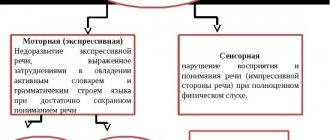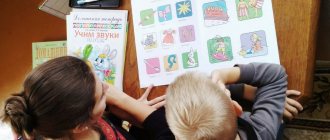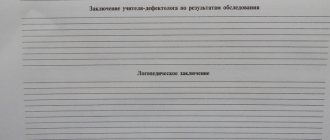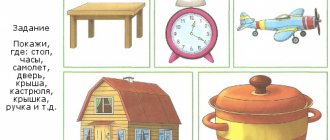Speech therapy presentation for PMPK for a 1st grade student,
Speech therapy presentation
per 1st grade student for PMPK
General sound of speech
: speech is incomprehensible, unformed intonation. The voice is quiet, muffled.
Lexicon:
significantly lags behind the age norm: ignorance of many words, the names of animals and their cubs, clothes, furniture, professions is revealed
.
The active vocabulary is limited to everyday topics and is qualitatively inferior. Does not know how to use word formation tools. The stock of adjectives and adverbs is narrow and monotonous.
Generalizing concepts are formed at the everyday level. The passive vocabulary is much wider than the active one.
Sound pronunciation:
(l) - (l`), sh-sch, ts-t`, ts-ch, velar pronunciation p, p`, violation of softness of consonants: (“pat” - five).
Phonemic processes:
not formed. Phonemic development is significantly behind the norm. Even simple forms of phonemic analysis are missing. Often, when correctly reproducing the contour of words, the sound content is disrupted: rearrangement of syllables, sounds, replacement and assimilation of syllables (“morashki” - daisies, “kukika” - strawberry). Polysyllabic words are reduced.
I learned to identify sounds in words like (house, poppy, moon) when pronouncing the syllables and sounds clearly and protractedly.
Syllable structure
: grossly violated. I learned to reproduce a simple rhythm by clapping and tapping.
The lack of formation of the rhythmic structure of both words and phrases is accompanied by a violation of the melody, tempo, and rhythm of speech. During reflected pronunciation, he produces only an approximate outline, an unclear sound complex instead of a word, and uses several variants of distortion of the same word.
Can repeat two- and three-syllable words with straight syllables like (mom, dad, milk, car), one-syllable words like (poppy, house) without a combination of consonants.
Syllables and words are not pronounced together.
When reproducing words with a cluster of consonants, omissions of consonant sounds of the cluster, addition of vowels within the cluster and other distortions are observed (window - “yako”, boat - “loka” - star - “seeing”). Often, when correctly reproducing the contour of words, the sound content is disrupted: rearrangement of syllables, sounds, replacement and assimilation of syllables (“morashki” - daisies, “kukika” - strawberry). Polysyllabic words are reduced.
Grammatical structure
: There are gross errors in the use of grammatical structures; he uses only simple sentences.
He experiences many difficulties when using prepositional constructions: prepositions are omitted altogether, and the noun is used in its original form (“the book goes then” - the book lies
on the table).
Understands the meaning of prepositions (on, under), but does not use them in speech.
Makes mistakes when forming the genitive case form. Most often, the sentence structure uses nouns in the nominative case, and verbs in the infinitive form or in the third person singular or plural form.
The agreement between the verb and the noun in number (“the lessons are over”, “the girl is sitting”), in gender (“the mother bought it”, “the girl went to”, etc.) is broken. Past tense verbs in speech are replaced by present tense verbs (“Vitya painted the house” , instead of “Vitya is drawing a house”).
Adjectives are used extremely rarely and do not agree with the nouns in gender and number (“red ribbon”, “delicious mushrooms”). Forms of nouns, adjectives and neuter verbs are missing, replaced or distorted.
Connected speech:
not formed.
Spontaneous speech is not intelligible .
Reading
: knows letters, reads syllables. When reading, substitutions are observed, adding letters at the end of words, and a violation of the softness of consonants. From the words I read, I understood individual words that have a simple syllable structure (lemons, raspberries). Doesn't understand the phrase he read.
Letters
o: Can copy words and short sentences without errors. Doesn't always translate printed letters into written ones. The work is slow.
I learned to write individual words from dictation while pronouncing them clearly and drawn out syllable by syllable.
There is a violation of the softness of consonants, replacement of t-ch.
Speech therapy conclusion: ONR-2. Motor alalia.
Date Speech therapist
multiurok.ru
How to write
When filling out the document, you can rely on the data of a psychologist on the staff of the educational institution. The characteristics can be drawn up on plain paper or on a form. It must be objective, information is displayed clearly and correctly, and errors are unacceptable. The main points of the characteristics are universal, deviation from them is minimal and depends on the purpose of the document.
Required items:
- personal data;
- family composition;
- accommodations;
- physical condition (special attention to vision and hearing);
- character traits;
- degree of mastery of subjects;
- conclusion (brief summary);
- teacher's recommendations.
The characteristic can be psychological or pedagogical. The best option is a combination of both components (psychological - pedagogical).
Representation of a speech therapist teacher for a child (for PMPK)
Characteristics of a speech therapist teacher for a child (for primary care consultations)
Child's full name
Date of Birth
Address
No. DOW
Group
- Purpose of contacting PMPK
- Speech environment (speech deficiencies in adult family members, bilingualism)
- Early speech development (humming, babbling, first words, phrases, developmental development, whether speech development was interrupted)
- Was speech therapy assistance provided to the child (where, when?)
- Features of the structure and mobility of the articulatory apparatus
- State of respiratory and vocal function
- Sound pronunciation (isolated pronunciation, in words, phrases; substitutions, confusion, omissions, distortion of sounds - examples of speech)
- Phonemic perception (which sounds are not differentiated by acoustic characteristics, at the level of syllables, words; the state of phonemic analysis and synthesis)
- State of the dictionary (understanding of spoken speech, whether passive and active vocabulary is age-appropriate, there is no exact meaning of words, adjectives, pronouns are rarely used, etc.)
- The grammatical structure of speech (how it handles the function of inflection, word formation - examples of speech)
- Coherent speech (what phrases are used, the nature of the story, the presence of linguistic and expressive means)
- Symptoms of stuttering
Conclusion: Date: Speech therapist teacher: ( )
Loading...
logoportal.ru
For a student chef, following the basics of writing
Basically, the characteristics are provided from the place of internship (industrial, pre-graduation). It is drawn up on the organization’s letterhead and reflects the student’s level of preparation and ability to use the acquired knowledge in the process of activity.
The characteristics of a chef apprentice consist of the following points:
- The title contains the details of the organization.
- The student’s details are indicated (full name, type of internship, name of organization, time of completion).
- The duties performed are listed (washing and preparing food, preparing dishes).
- Acquired skills are indicated (mastered new cooking technologies).
- Personal characteristics (attitude to work, degree of desire for knowledge, attitude to criticism, ability to work in a team).
- Conclusion (the result of the internship is assessed).
- The official, his signature, and the seal of the organization are indicated.
Share with friends or Save for yourself!
More documents from the pedagogy category:
If students have problems with sound pronunciation, individual-subgroup work is carried out according to the generally accepted scheme using speech material adapted for a given age.
The following character traits predominate: fairness, tact, responsiveness. Always had his own point of view. In the class he enjoyed authority among the students. He took part in the social life of the class and school. He always handled assignments conscientiously.
M. participates in all extracurricular activities and socially useful activities. She does not remain indifferent to everything that happens in the classroom and school.
Vladimir is characterized by such qualities as determination, independence and activity. Temperament is defined as sanguine (60%) and choleric. This explains the student’s ability to work, but at the same time the boy is unstable in his hobbies and often changes his areas of interest. Vladimir’s positive qualities, of course, include optimism, energy, responsiveness, and perseverance.
Sample positive reference for a girl school student
Features of behavior: 9.1. Positive actions of the student, how often they are performed, possible motives for their commission.
Petrov Vladimir Nikolaevich - student 6 "A" class secondary school 35 of the city Lk. Born on June 24, 2001. After a medical examination, he was enrolled in health group 1. Main group for physical education. Hardening is recommended.
There are a number of certain rules that must be followed when drawing up a psychological and pedagogical characteristics. First of all, the characteristic must be of a mandatory objective nature; it is necessary to take into account the factors that influence the formation of the child’s personality, as well as his individual characteristics.
You can ask for this document directly from the class teacher, social worker or deputy director of the school.
Ready-made examples (samples) of characteristics for secondary school students
Vanya has not developed sanitary and hygienic skills, the teenager is dirty, unkempt, does not take care of himself and is indifferent to his appearance.
Efficiency: low, far behind the general pace of children of this age, very often does nothing.
Vladimir has his own room, so nothing prevents him from studying and doing his homework. Answering the questionnaire, the boy said that he performs some household duties: goes to the store, takes out the trash, waters the flowers. From this we can conclude that Vladimir’s parents instill hard work and accuracy.
When filling out the MSE, it is recommended to disclose as fully as possible the activities and behavior of the disabled person, his condition during the performance of educational activities. There are samples for this.
The student does not have sufficient knowledge and ideas about the world around him. Educational activity is at a low level.
She follows all the rules of the school schedule and does not miss lessons for no reason. He holds the post of assistant to the school president, is a member of the student Parliament and the School Council. Dreams of becoming an investigator.
Compliance of physical development with age standards. The child’s level of performance, development of gross and fine motor skills, spatial orientation. Movement disorders (stereotypical and obsessive movements, stiffness, disinhibition, paralysis, paresis). Coordination. Condition of analyzers (vision, hearing and others). Presence of chronic diseases.
Conversely, the same symptoms can be observed in forms of speech disorders with different mechanisms.
General awareness: corresponds to the age level, has information about the world around them in accordance with age.
Self-esteem:
- adequacy of self-esteem in difficult situations and matters;
- what he wants, level of desires;
- what position he occupies or wants to occupy among his classmates.
At the preparatory stage, the simple prerequisites for mastering spelling (visual gnosis, mnesis, optical-spatial representations) created during the learning process in primary school are clarified; work is being done to develop such mental operations as analysis, synthesis, comparison, comparison.
Very often misses classes without good reason. Does not show initiative in social activities. He often refuses to participate in public affairs and tries to avoid any work.
Psychological and pedagogical features
The characteristics of a weak 9th grade student have the main part - actually, pedagogical data about the child and his psychological portrait. It is important to indicate the following here:
- attitude towards educational activities;
- academic performance and interest in specific subjects;
- participation in classroom and extracurricular activities;
- academic success and achievements;
- discipline;
- development of cognitive processes (thinking, attention, memory, imagination, speech);
- emotional reactions;
- adolescent self-esteem;
- character traits;
- abilities, interests and inclinations;
- communication skills, leadership abilities and the nature of communication with others;
- having friends;
- the severity of the tendency towards deviant behavior.
In order for the preparation of the document not to be so labor-intensive, the teacher can use the Map-scheme of the student’s characteristics, where data on his development was recorded throughout the child’s education. Using the Scheme Map, you can also trace the dynamics of the development of individual student traits and indicate this in the characteristics.
Example of typical characteristics for students – Free Legal Aid
An analysis of characteristic emotions is carried out, their stability, how restrained, hot-tempered, and irritable the child is. What is his emotional excitability, impressionability, and touchiness. If necessary, the degree of aggressiveness or depression of the student is indicated.
During his studies at MBOU Secondary School ____ the child showed poor knowledge in basic academic subjects. A teenager has insufficiently developed skills and abilities necessary to master educational material, which leads to poor performance.
Important: Parents' relationships with the class teacher and teachers are friendly. The family devotes sufficient time to issues of upbringing, development and health of the child.





